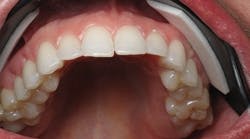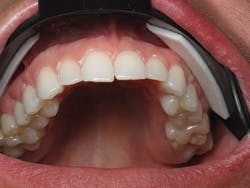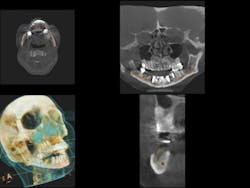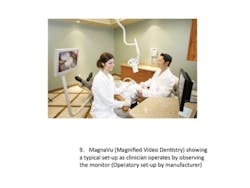In this monthly feature, Dr. Gordon Christensen addresses the most frequently asked questions from Dental Economics® readers. If you would like to submit a question to Dr. Christensen, please send an e-mail to [email protected].
For more on this topic, go to www.dentaleconomics.com and search using the following key words: magnification, loupes, TTL, clinical microscopes, Dr. Gordon Christensen.
QI'm confused about the level of magnification desirable for clinical dental practice. I have used loupes for several years with success, but I continue to hear speakers promote clinical microscopes or other magnifying devices as more adequate than loupes. Is it time to change to higher magnification or are conventional loupes still acceptable?A Your question is certainly timely. There is no question about the desirability of magnification when operating. I am pleased to note that most dental schools encourage dental students to use loupes, and additionally, dental hygienists have discovered the desirability of magnification while accomplishing dental hygiene procedures. I have suggested that dental assistants could also benefit from loupes for some procedures. Are loupes adequate for most procedures, used at the magnification levels most dentists and dental hygienists use them? I will answer your question by discussing not only loupes, but microscopes and other magnifying devices.Loupes
Using magnification while operating has been in dentistry for over 50 years and has evolved through numerous different modes of application, ranging from attaching the loupe to standard or special glasses, placing the loupe on a rod extending from a head band, and numerous other methods.
In recent years, the most popular mode has been to attach the magnifier lenses to the lens of the glasses, forming what is called "through the lens" (TTL) magnification. "Flip-up" loupes are available, but manufacturers tell me that the TTL lens is in greater demand.
Most dentists and some dental hygienists use loupes on a routine basis. The majority report that they are comfortable with the loupes and the magnification they are using, and that they are not looking for additional higher magnification. You may or may not come to this conclusion after you consider the other magnification levels available for dental professionals.
Dentists and dental hygienists vary in the magnification level they desire. Most prefer 2.5x for day-to-day use. Some practitioners use up to 4x or more for routine use, but many use these higher magnifications for only some procedures.
Magnification powers are rated differently by some companies. For example, 3.5x loupes by some companies may be equivalent to 2.5x loupes by other companies. Additionally, the visual acuity of loupes decreases as the working distance increases.
Therefore, tall clinicians usually need higher magnification power loupes than clinicians of average height. Some loupe manufacturers tell me that some clinicians are purchasing loupes with magnification as high as 8x. However, the higher the magnification, the smaller the depth and width of the field of vision. This limits the clinicians' ability to accomplish tasks that demand a larger field of operation.
The solution to these frustrating conditions is to try on loupes from the companies in which you have an interest while at dental meetings. The loupes should feel comfortable, your neck should not be strained, and the angle of declination (looking down angle) should be adjusted to your specific situation.
There are numerous loupe companies. The three most popular are Designs for Vision, Orascoptic, and SurgiTel (Figs. 1-6). Currently Orascoptic has the most market share.
As with any delicate visual adjunct to dental practice, the loupes must be stored, used, and cleaned carefully to avoid scratches or getting them out of alignment. It is suggested that cleaning the loupes should be done with either non-wood fiber containing wipes (such as Kimwipes, which are available from most dental distributors), a cotton towel, any cotton cloth, or microfiber cloths designed to clean glasses.
If the loupes are especially dirty with blood or debris, they can be moistened under running water (avoid full immersion in liquid), and gently wiped off. Kleenex or paper towels will scratch the lens and should not be used.
Some companies and clinicians are suggesting the use of liquid disinfectants on the loupes, but the actual antimicrobiologic activity of some of these solutions is questionable. Lysol IC (79% ethyl alcohol-containing spray followed by wiping) is the preferred disinfectant for such applications.
Are you looking for more magnification than you currently have with loupes? If so, other concepts are available.
Clinical microscopes
Various brands of microscopes have been used in the dental laboratory for years to facilitate better vision when fabricating crowns, as well as fixed and removable prostheses. Although clinical microscopes have been available for several years, dentists have been slower to accept them than when loupes were introduced to the profession. However, microscope use is high among endodontists and others involved with endodontics. The dominant clinical microscope companies are Global and Zeiss in the United States (Figs. 7 and 8). Clinical microscopes offer magnification 20x or higher.
It is interesting to note the diverse opinions on the desirability of clinical microscopes. Some dentists use them on a routine basis for the entirety of many clinical procedures, including restorative dentistry. Others use them only for finalizing tooth preparations, analyzing finished or questionable restorations, and other occasional tasks. The dentists who use microscopes for only some procedures usually use conventional loupes for the major portion of the procedure and shift to a microscope for the completion.
Contrary to those who like and promote microscopes, some dentists have tried them and have found that they do not like the relatively long learning curve, the shallow depth of field, the high initial cost, and the reduced speed usually noted when operating under high magnification.
I suggest that you try a clinical microscope at an upcoming dental meeting to see if the concept fits your practice. In spite of the known advantages of clinical microscopes, to date the most significant microscope acceptance has been in practices oriented toward endodontics.
A unique magnification concept
Years ago, I tried to operate while viewing 2D images on a monitor. After a learning period, I found I could do this for a few simple to moderately difficult procedures. By accomplishing these procedures while viewing the monitor, I could sit up straight, thereby reducing any poor posture required for some conventional operating positions. However, intraoral television cameras of that era were still in development at the time and I did not continue with the experimentation.
A new concept, the MagnaVu (Magnified Video Dentistry) has enhanced and further developed that concept to a remarkable degree (Fig. 9). It was designed to help dentists and dental staff accomplish most dental procedures while sitting in a more upright, heads-up, relaxed position.
The clinician views the operating field on a monitor directly in front of the patient. After learning how to use the MagnaVu, which takes a few weeks, most simple to moderate oral procedures can be accomplished without difficulty.
The magnification levels range from 1x to 23x. The deep 4" depth of field is remarkable and adapts to procedures from a root canal to an entire arch, or with repositioning, a full face. The device has a powerful LED light that allows treatment from one tooth to an entire arch.
The company also has an ergonomic operating chair that allows the clinician to sit in a less strained position. The device was designed to take the place of cameras, loupes, microscopes, and operatory lights. If this concept interests you, please look up MagnaVu at an upcoming dental meeting and try their device. It may sound difficult at first, but so did the dental mirror, which you have now mastered. This concept and further advancements have high potential.
Loupes and scopes
◊ Dental magnifying loupes have finally been fully accepted by the dental profession. Only a few dentists now operate without the help of magnification by loupes. Do you want higher magnification while operating?
◊ Clinical microscopes provide higher magnification; however, they are used primarily by those doing endodontics and a few devoted advocates who have determined the value of higher magnification and learned to operate while using them. Only you can determine if this concept fits you.
◊ The MagnaVu Dental Procedure Scope allows operating from a monitor in magnification up to 23x. This new concept may be as exciting to you as it is to me. A simple demonstration by the manufacturer will support or reduce your enthusiasm.
Endodontic therapy is a significant part of dental practice. Loupe and microscope use is considered to be "standard-of-care" in endodontics.
My endodontist colleague, Dr. Cliff Ruddle, offers the best in endodontic video education. Five highly educational DVDs made by Dr. Ruddle are available from our Practical Clinical Courses DVD library.
R1330, Shape, Clean, Pack by Dr. Ruddle has been the most popular. All five of them are excellent. V1908, The Best Posts, Cores, and Build-Up Techniques by Gordon Christensen is a logical follow-up to Dr. Ruddle's presentations. Go to www.pccdental.com or call (800) 223-6569 for further information.









